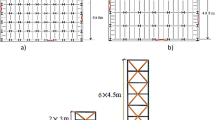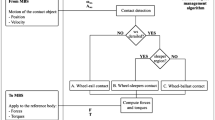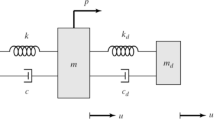Abstract
The box girder bridges constructed using the balanced cantilever construction method have been widely adopted to avoid damage due to unequal settlement of the foundations. The balanced cantilever type bridges are distinct from the other bridges in support conditions and are particularly useful for long-span length. The correct estimation of the impact factor due to vehicle bridge interaction force is essential for designing such bridges. This issue has been addressed in the present work, and a simple expression for the impact factor estimation of balanced cantilever-type bridges has been suggested. The suggested impact factor expression is a function of bridge span length and road surface condition (RSC). The study has been performed on different bridge span lengths, different vehicle speeds, and five different RSCs. The ASSTHO HS20-44 Truck has been considered for the vehicle bridge interaction analysis. A generated MATLAB code has solved the dynamic vehicle–bridge interaction coupled equation, and the modal properties of the bridge have been extracted from the FEM software MIDAS civil. The developed simple expression in terms of bridge span length and RSC to estimate impact factor can be used for the design and performance evaluation of balanced cantilever-type bridges.

















Similar content being viewed by others
Data Availability Statement
All data, models, and code generated or used during the study appear in the submitted article.
References
Çadraku HS, Jagxhiu B (2020) Sustainability and functionality of railway network and its connecting facilities in Kosovo. J Human Earth Future 1(3). https://doi.org/10.28991/HEF-2020-01-03-02
Huang D, Wang T-L, Shahawy M (1992) Impact analysis of continuous multi-girder bridges due to moving vehicles. J Struct Eng. https://doi.org/10.1061/(ASCE)0733-9445(1992)118:12(3427),3427-3443
Humar J, Kashif AH (1995) Dynamic response analysis of slab-type bridges. J Struct Eng 121(1):48–62
Deng L, Yu Y, Zou QL, Cai CS (2015) State-of-the-art review on dynamic impact factors of highway bridges. J Bridge Eng 20(5).
Yu Y, Cai CS, Deng L (2016) State-of-the-art review on bridge weigh-in-motion technology. Adv Struct Eng 19(9):1514–1530
Cantieni R (1984) Dynamic load testing of highway bridges. Transp Res Rec 950:141–148
Chan THT, O’Connor C (1990) Wheel loads from highway bridge strains: field studies. Eng Struct 116(7):1751–1771
Sennah KM, Zhang X, Kennedy JB (2004) Impact factors for horizontally curved composite box girder bridges. J Bridg Eng 9(6):512–520
Ding L, Hao H, Zhu X (2009) Evaluation of dynamic vehicle axle loads on bridges with different surface conditions. J Sound Vib 323(3–5):826–848
Hamidi SA, Danshjoo F (2010) Determination of impact factor for steel railway bridges considering simultaneous effects of vehicle speed and axle distance to span length ratio. Eng Struct 32(5):1369–1376
Caprani C (2012) Lifetime highway bridge traffic load effect from a combination of traffic states allowing for dynamic amplification. J Bridg Eng 18(9):901–909
Wang B, He H (2017) Vehicle-bridge interaction analysis based on the ANCF quasi-conforming plate technique. IOP Conf Ser Mater Sci Eng 216:1–5
Chang D, Lee H (1994) Impact factors for simple-span highway girder bridges. J Struct Eng 120(3):704–715
Huang D, Wang TL, Shahawy M (1992) Impact studies of multi girder concrete bridges. J Struct Eng 119(8):2387–2402
Deng L, Cai CS (2010) Development of dynamic impact factor for performance evaluation of existing multi-girder concrete bridges. Eng Struct 32(1):21–31
Deng L, Yu Y, Zou Q, Cai CS (2015) State-of-the-art review of dynamic impact factors of highway bridges. J Bridg Eng. https://doi.org/10.1061/(asce)be.1943-5592.0000672
Özşahin E, Pekcan G (2020) Inelastic seismic response of box-girder bridges due to torsional ground motions. Eng Struct. https://doi.org/10.1016/j.engstruct.2020.110831
Rambo-Roddenberry M, Kuhn D, Glenn TR (2016) Barrier effect on transverse load distribution for prestressed concrete segmental box girder bridges. J Bridg Eng. https://doi.org/10.1061/(asce)be.1943-5592.0000814
Ramanathan K, Padgett JE, DesRoches R (2015) Temporal evolution of seismic fragility curves for concrete box-girder bridges in California. Eng Struct. https://doi.org/10.1016/j.engstruct.2015.03.069
Gentile R, Nettis A, Raffaele D (2020) Effectiveness of the displacement-based seismic performance assessment for continuous RC bridges and proposed extensions. Eng Struct. https://doi.org/10.1016/j.engstruct.2020.110910
Cardellicchio A, Ruggieri S, Nettis A, Renò V, Uva G (2023) Physical interpretation of machine learning-based recognition of defects for the risk management of existing bridge heritage. Eng Fail Anal 149:107237. https://doi.org/10.1016/j.engfailanal.2023.107237
Nettis A, Iacovazzo P, Raffaele D, Uva G, Adam J (2022) Displacement-based seismic performance assessment of multi-span steel truss bridges. Eng Struct 254:113832. https://doi.org/10.1016/j.engstruct.2021.113832
Nettis A, Massimi V, Nutricato R, Nitti DO, Samarelli S, Uva G (2023) Satellite-based interferometry for monitoring structural deformations of bridge portfolios. Autom Constr 147:104707. https://doi.org/10.1016/j.autcon.2022.104707
Alonso AG, Sanchez DG, Aldaca IC., Castillo CL (2022) Novel method for an optimised calculation of the cross-sectional distribution of live loads on girder bridge decks. Civil Eng J 8(03). https://doi.org/10.28991/CEJ-2022-08-03-01.
Soe, Khaing (2020) Evaluation of cable force changes effects on cable stayed bridge. Civil Eng J 6(11). https://doi.org/10.28991/cej-2020-03091609
Pisal AY, Jangid RS (2016) Vibration control of bridge subjected to multi-axle vehicle using multiple tuned mass friction dampers. Int J Adv Struct Eng 8:213–227. https://doi.org/10.1007/s40091-016-0124-y
Kataria NP, Jangid R (2016) Seismic protection of the horizontally curved bridge with semi-active variable stiffness damper and isolation system. Adv Struct Eng 19(7):1103–1117
IRC-06 (2014): Standard Specifications and Code of Practice for Road Bridges, Section II—Loads and Stresses (Fourth Revision).
AASHTO (American Association of State Highway and Transportation Officials), Standard Specification for Highway Bridges, AASHTO, Washington, DC, USA, 17th edition, 2002.
BS EN 1991–2, Eurocode 1: Actions on Structures-Part 2: Traffic Loads on Bridges, British Standard Institution, London, UK, 2003.
Clough RW, Penzien J (1993) Dynamics of structures. McGraw-Hill, New York.
International Organization for Standardization (ISO) (2016) Mechanical vibration-road surface profiles-reporting of measured data. ISO 8608 (2016) E. ISO, Geneva
Acknowledgements
This is an original work, and the author has not received any funds from anywhere else.
Funding
Not applicable.
Author information
Authors and Affiliations
Corresponding author
Ethics declarations
Conflict of interest
All the authors declare that they have no conflict of interest.
Ethical approval
This article does not contain any studies with human participants or animals performed by any of the authors.
Informed consent
For this study formal consent is not required.
Rights and permissions
Springer Nature or its licensor (e.g. a society or other partner) holds exclusive rights to this article under a publishing agreement with the author(s) or other rightsholder(s); author self-archiving of the accepted manuscript version of this article is solely governed by the terms of such publishing agreement and applicable law.
About this article
Cite this article
Nunia, B., Prashanth, J. & Choudhury, S. Development of impact factor expression for the design and performance evaluation of long-span-balanced cantilever-type prestressed box girder bridges. Innov. Infrastruct. Solut. 8, 296 (2023). https://doi.org/10.1007/s41062-023-01251-1
Received:
Accepted:
Published:
DOI: https://doi.org/10.1007/s41062-023-01251-1




